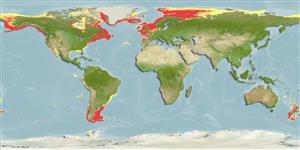Common names from other countries
Environment: milieu / climate zone / depth range / distribution range
Écologie
; profondeur 4 - 545 m (Ref. 120471). Subtropical
Arctic, Atlantic and Pacific Oceans. Mostly polar, but also in subtropical and boreal climates.
Length at first maturity / Taille / Poids / Âge
Maturity: Lm ? range ? - ? cm
It is epizoic on other hydroids, Obelia dichotoma at depths of 20 to 30 m (Ref. 87801). Overall depth range of 4 to 545 m (Ref. 120471). Found in coastal waters and often grew on other animals (Ref. 64386).
Life cycle and mating behavior
Maturité | Reproduction | Frai | Œufs | Fécondité | Larves
Reproduction occurs only in hydroid stage (Ref. 1663, p. 19).
Cairns, S.D., D.R. Calder, A. Brinckmann-Voss, C.B. Castro, D.G. Fautin, P.R. Pugh, C.E. Mills, W.C. Jaap, M.N. Arai, S.H.D. Haddock and D.M. Opresko. 2003. (Ref. 1663)
Statut dans la liste rouge de l'IUCN (Ref. 130435)
statut CITES (Ref. 108899)
Not Evaluated
Not Evaluated
Utilisations par l'homme
| FishSource |
Outils
Plus d'informations
Taille/Âge
Croissance
Longueur-poids
Longueur-longueur
Morphologie
Larves
Abondance
Sources Internet
Estimates based on models
Preferred temperature
(Ref.
115969): 1.1 - 12.1, mean 7.2 (based on 167 cells).
Catégorie de prix
Unknown.
